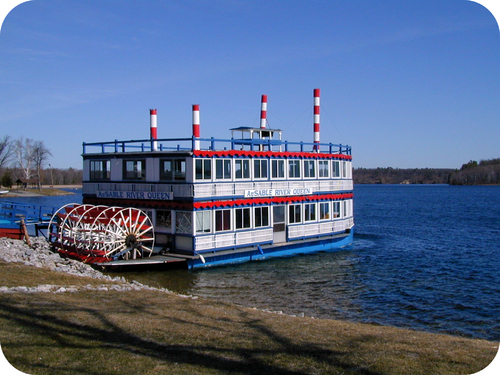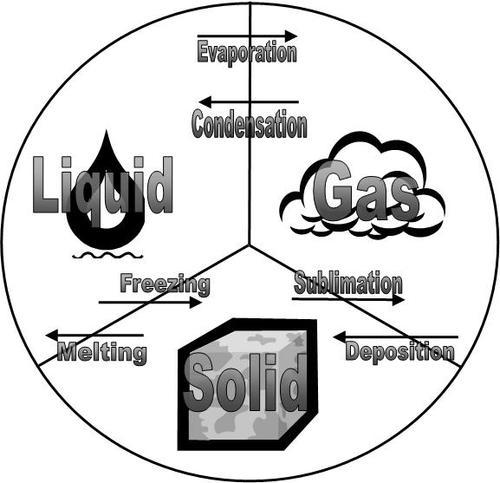Why Did the Temperature of a Hand Warmer Stabilize Instead of Continuing to Rise
Learning Objectives
- List the changes of state.
- Relate the change of state to a change in temperature.
Examples

How is it that steamboats contain so much power?
During the time of Mark Twain (real name Samuel Langhorne Clemens, 1835-1910), the steamboat was a major means of transportation on the rivers and lakes of the United States. Twain himself was a steamboat pilot on the Mississippi River for a period of time and took his pen name from the measurement of water depth (twelve feet, which was a safe depth for the boats). The boats got their power from steam – liquid water converted to a gas at high temperatures. The steam would push the pistons of the engine, causing the paddle wheels to turn and propel the boat.
Heating Curves
Imagine that you have a block of ice that is at a temperature of -30°C, well below its melting point. The ice is in a closed container. As heat is steadily added to the ice block, the water molecules will begin to vibrate faster and faster as they absorb kinetic energy. Eventually, when the ice has warmed to 0°C, the added energy will start to break apart the hydrogen bonding that keeps the water molecules in place when it is in the solid form. As the ice melts, its temperature does not rise. All of the energy that is being put into the ice goes into the melting process and not into any increase in temperature. During the melting process, the two states – solid and liquid – are in equilibrium with one another. If the system was isolated at that point and no energy was allowed to enter or leave, the ice-water mixture at 0°C would remain. Temperature is always constant during a change of state.
Continued heating of the water after the ice has completely melted will now increase the kinetic energy of the liquid molecules and the temperature will rise. Assuming that the atmospheric pressure is standard, the temperature will rise steadily until it reaches 100°C. At this point, the added energy from the heat will cause the liquid to begin to vaporize. As with the previous state change, the temperature will remain at 100°C while the water molecules are going from the liquid to the gas or vapor state. Once all the liquid has completely boiled away, continued heating of the steam (remember the container is closed) will increase its temperature above 100°C.
The experiment described above can be summarized in a graph called a heating curve ( Figure below ):

Figure 13.23
In the heating curve of water, the temperature is shown as heat is continually added. Changes of state occur during plateaus because the temperature is constant.
The change of state behavior of all substances can be represented with a heating curve of this type. The melting and boiling points of the substance can be determined by the horizontal lines or plateaus on the curve. Other substances would of course have melting and boiling points that are different from those of water. One exception to this exact form for a heating would be for a substance such as carbon dioxide which sublimes rather than melts at standard pressure. The heating curve for carbon dioxide would have only one plateau, at the sublimation temperature of CO 2 .
The entire experiment could be run in reverse. Steam above 100°C could be steadily cooled down to 100°C, at which point it would condense to liquid water. The water could then be cooled to 0°C, at which point continued cooling would freeze the water to ice. The ice could then be cooled to some point below 0°C. This could be diagrammed in a cooling curve that would be the reverse of the heating curve.
Summary of State Changes
All of the changes of state that occur between solid, liquid and gas are summarized in the diagram in the figure below. Freezing is the opposite of melting and both represent the equilibrium between the solid and liquid states. Evaporation occurs when a liquid turns to a gas. Condensation is the opposite of vaporization and both represent the equilibrium between the liquid and gas states. Deposition is the opposite of sublimation and both represent the equilibrium between the solid and gas states.

Figure 13.24
Solid, liquid, and gas states with the terms for each change of state that occurs between them.
Key Takeaways
Summary
- A change of state can be brought about by putting heat into a system or removing it from the system.
- The temperature of a system will not change as long as the substance is undergoing a change from solid to liquid or liquid to gas, as well as the reverse.
Exercises
Practice
You can experiment with pressure, temperature and phases using this simulation
http://www.pbs.org/wgbh/nova/physics/states-of-matter.html
Change the temperature, pressure, and substance and record your observations.
Exercises
Review
Questions
- What happens when ice reaches 0°C?
- What is sublimation?
- What happens to steam if it is cooled to 100°C?
Glossary
- condensation: The process of a gas turning to a liquid. The opposite of vaporization and both represent the equilibrium between the liquid and gas states.
- deposition: The process of a gas turning to a solid. The opposite of sublimation and both represent the equilibrium between the solid and gas states.
- evaporation: Occurs when a liquid turns to a gas.
- freezing: The process of a liquid turning to a solid. The opposite of melting and both represent the equilibrium between the solid and liquid states.
- gas: State of matter that fills all available space.
- liquid: State of matter with a definite volume and takes the shape of its container.
- melting: The process of a solid turning to a liquid.
- solid: State of matter with a definite shape and volume.
- sublimation: The process of a solid turning to a gas.
Show References
johnsonlowent1951.blogspot.com
Source: https://www.coursehero.com/study-guides/cheminter/heating-and-cooling-curves-also-called-temperature-curves/

0 Response to "Why Did the Temperature of a Hand Warmer Stabilize Instead of Continuing to Rise"
Post a Comment